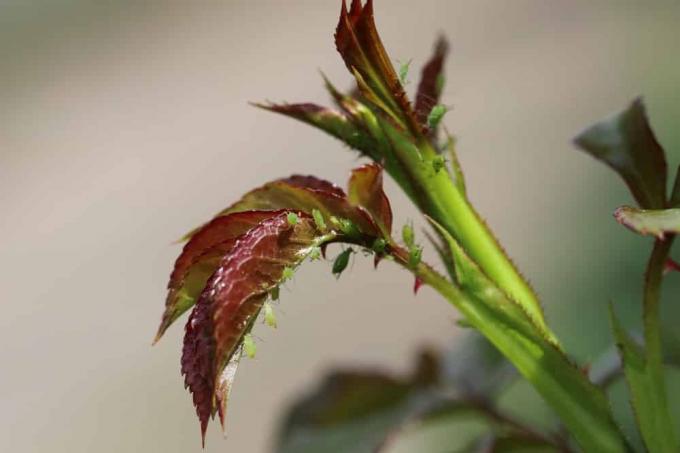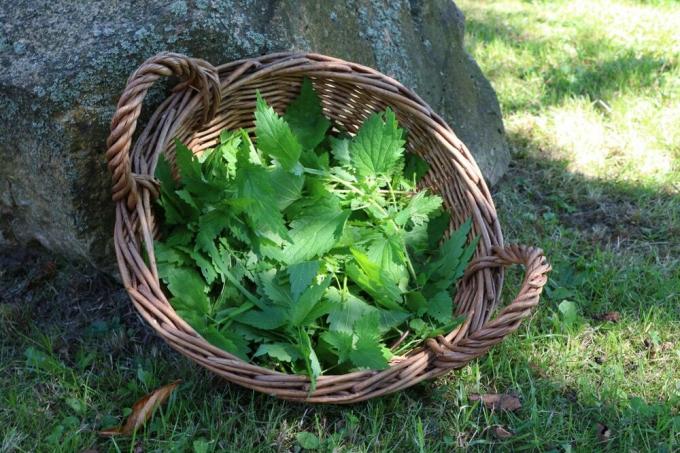

Table of contents
- Common native species
- Pea Aphid (Acyrthosiphon pisum)
- Black bean aphid (Aphis fabae)
- Green peach aphid (Myzus persicae)
- Large rose aphid (Macrosiphum rosae)
- propagation
- combat
- Fern tea
- soft soapy water
- Prevent aphids
- Natural enemies
- plant herbs
- strengthen plants
The aphid sucks the sap from the plants, weakening them. The damaged areas on the plant epidermis also offer pathogens the opportunity to penetrate, which is why you should get rid of the lice quickly.
Common native species
There are around 850 species of aphids native to Europe alone. Some of them specialize in certain plants, like the bean aphid on beans and other legumes. The species that are part of the tube aphid family are particularly problematic for hobby gardeners (Aphidoidea) condition. They mainly infest fruit and vegetables and occasionally also flowers or plants. Ornamental shrubs in the garden. The coloring of the aphid species often varies depending on their food sources or living conditions and there are yellow, black and red species in addition to green ones.
Pea Aphid (Acyrthosiphon pisum)
- Size: 2-4mm
- Color: green to yellowish (rarely reddish)
- airworthy
- Damage: Host plants are deprived of important nutrients; Carriers of viruses with leaf roll and mosaic symptoms
The greenish to yellow pea aphid is found on a variety of legumes. In addition to peas, it is often found on field beans or lentils. It also attacks exotic plants such as fenugreek.
Black bean aphid (Aphis fabae)
- Size: 1.7-2.7mm
- Color: matte black or dark green
- unable to fly
- Damage: Virus and fungus carriers (black fungus); Symptoms of leaf curling and curling of shoot tips
The bean aphid is mainly found on beans, but also infests plants such as potatoes or turnips. The Himalayan balsam, which is spreading widely as a neophyte in Central Europe, is particularly popular. However, the black bean aphid does not overwinter on its food plants, but in shrubs such as the snowball (Viburnum opulus) or the euonymus (Euonymus europaeus).
Green peach aphid (Myzus persicae)
- up to 2 mm long
- Color: black-brown
- able to fly (wings greenish)
- Damage: Symptoms of leaf curl, signs of yellowing
The green peach aphid is found exclusively on peach trees.
Large rose aphid (Macrosiphum rosae)
- Size: 3-4mm
- Color: black (head), green - pink (body), rarely red specimens
- mostly flightless
- Damage: warping, discoloration; Carrier of sooty mold fungi

The large rose aphid specializes in roses. It is often difficult to recognize because there are not only green specimens, but also red ones. Only when generations with wings are produced does a change to other host plants occur. Then they usually colonize teasel or valerian plants. In late summer, the rose aphids migrate back to their preferred food source, the roses.
A notice:
White lice are often equated with aphids. However, white lice do not belong to the aphid family, but to the whitefly.
propagation
One reason aphids become a problem is because they can multiply rapidly. If there is no male available, aphids can reproduce without being fertilized by another specimen. If there is not enough space on a plant, they often produce offspring that urgently need pollination. These offspring usually colonize new host plants and their offspring can reproduce again without males. Within a few weeks, females can produce numerous offspring, which means that up to forty generations are possible.
Winged offspring are less common in aphids. A trigger for winged offspring is when habitat becomes too scarce and they need to colonize new areas or when enemies threaten them. When a group of aphids is attacked by an enemy such as a ladybug, they emit a special scent that causes the next generation to grow wings.
combat
Aphids produce sweet honeydew that is sought after by ants. Therefore, lice populations are often maintained by these insects, which favor an increasing population. Therefore, it often makes more sense to first remove the ant nests and then fight the aphids in the next step. The easiest way is to relocate the ant nests. To do this, the ant nest is first located and then a large pot is placed over the spot. After several days, the insects will have moved their nest into the pot and you can dig up the ants' nest with a spade and move it to a place where they will not cause any damage.

Once the ants have disappeared, you can fight the aphids. There are various home remedies available to you that do not damage the plants and are also harmless to other insects, as they are often used to repel them.
Fern tea
- Chop 100 g bracken or male fern
- Boil 500 ml of water
- Pour hot water over the cabbage
- Leave for 24 hours
- Simmer for another 30 minutes the next day
- Dilute tea with 500 ml of cold water
- Treat affected plants repeatedly at intervals of 2 days
soft soapy water
- 50 g curd soap or soft soap
- 1 liter of hot (not boiling) water
- Grate soap and dissolve in water
- Spray plants with it every 2-3 days
A notice:
The advantage of soft soapy water is that it not only drives away the aphids, but also frees up stomata that are clogged with honeydew, which are important for plant respiration.
Prevent aphids
One possibility is to actively remove the aphids, but it is much better if you do so Prevent aphids, for example by settling natural enemies or plants that they don't like underplant.
Natural enemies
- Ladybugs (larvae and beetles)
- Lacewings (larvae and flies)
- parasitic wasp larvae
- assassin bugs
- ground beetle
plant herbs
Mediterranean herbs can also help prevent aphids and their protectors, the ants. The intense smell of the herbs drives away the insects. Popular repellents as underplanting are:
- lavender
- thyme
- savory
- peppermint
strengthen plants

Prepare a liquid manure as follows:
- fresh herb in the amount of 2/3 of the chosen container
- Roughly chop the cabbage
- Pour rainwater or tap water over until the container is full
The liquid manure has to stand for several weeks until most of the herb has decomposed. Dilute the liquid manure in a ratio of 1:10 and use it to water the plants. If the plants already have aphids, you can also apply the manure as a spray to the affected areas. The liquid manure is more of a long-term remedy. If you need a short-term available remedy, you can also prepare nettles as a broth. To do this, pour boiling water over 200 g of fresh and chopped herb and leave to stand for 72 hours. Then spray the plants with it.
 garden editorial
garden editorial I write about everything that interests me in my garden.
Learn more about aphids

Garlic against aphids: make garlic stock
Aphids usually appear overnight and quickly become a real nuisance. A proven home remedy for lice is garlic broth. The production of the biological crop protection product, which can be used indoors and outdoors, is easy.

Effectively combat aphids on lavender & jasmine
Effective home remedies have even been developed to combat stubborn plant pests. This guide explains how gardeners can rid their jasmine or lavender of lice with inexpensive and environmentally friendly treatments.

Prevent aphids | 6 home remedies to get rid of aphids
Anyone who manages a garden, maintains flower boxes or even has potted plants on their windowsill at home knows them - the aphids. You can find out here how you can avoid the influx of annoying visitors from the outset using simple home remedies.

Fighting lice on raspberries | 13 natural remedies against aphids
Raspberries taste best straight from the bush. However, for a good yield, the fruits and shrubs should be healthy and free from pests. You should do something against aphids in the spring, long before the fruit ripens.

Fight aphids on herbs biologically | 10 home remedies & beneficial insects
Aphids are unwelcome guests in the garden and like to spread on the tasty herbs. Unfortunately, these plants are very sensitive and suffer greatly from pest infestation, which can even lead to their death. As an antidote, biological alternatives to the chemical club are always to be preferred.

Fight aphids biologically - these 14 home remedies work
Aphids are found almost everywhere. And the small pests are not necessarily very choosy. They suck out the sap of plants and can cause a lot of damage. But you don't have to resort to chemical agents right away. There is a whole range of effective, biological means to effectively combat aphids.



